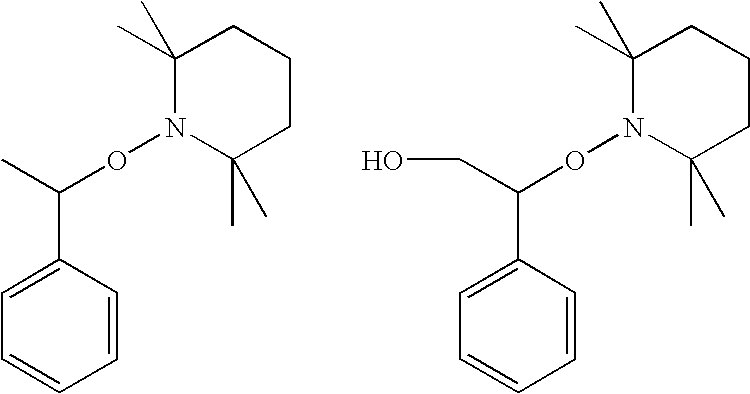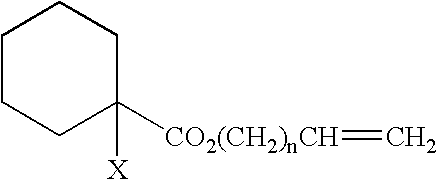Curable Composition
a technology of composition and elongation, applied in the field of elongation composition, can solve the problems of deterioration of weather resistance of polymer, lowering of gel proportion of cured product, and deterioration of high elongation property of polyether polymer, etc., and achieve excellent elongation and weather resistance
- Summary
- Abstract
- Description
- Claims
- Application Information
AI Technical Summary
Benefits of technology
Problems solved by technology
Method used
Image
Examples
production example 1
[0411]Under nitrogen atmosphere, CuBr (0.8 kg), acetonitrile (8.9 kg), butyl acrylate (12.5 kg), ethyl acrylate (3.7 kg), octadecyl acrylate (3.8 kg), and diethyl 2,5-dibromoadipate (1.6 kg) were added to a 250 L-reactor and stirred at 70 to 80° C. for about 30 minutes. Pentamethyldiethylenetriamine was added in order to start the reaction. Butyl acrylate (50.2 kg), ethyl acrylate (14.6 kg) and octadecyl acrylate (15.2 kg) were continuously supplemented over 2 hours after 30 minutes from the start of the reaction. During the reaction, pentamethyldiethylenetriamine was properly added and the inner temperature was kept at 70 to 90° C. The total amount of the pentamethyldiethylenetriamine consumed by that time was 158.5 g. After 4 hours from the start of the reaction, the reaction system was stirred under heating condition and reduced pressure at 80° C. for removing volatile components. Acetonitrile (35.7 kg), 1,7-octadiene (20.1 kg), and pentamethyldiethylenetriamine (316.5 g) were ad...
production example 2
[0417]Under nitrogen atmosphere, CuBr (1.0 kg), acetonitrile (11.6 kg), butyl acrylate (20.1 kg), methyl acrylate (2.1 kg), octadecyl acrylate (3.7 kg), and diethyl 2,5-dibromoadipate (2.2 kg) were added to a 250 L-reactor and stirred at 70 to 80° C. for about 30 minutes. Pentamethyldiethylenetriamine was added in order to start the reaction. Butyl acrylate (80.3 kg), methyl acrylate (8.7 kg) and octadecyl acrylate (15.1 kg) were continuously supplemented over 2 hours after 30 minutes from the start of the reaction. During the reaction, pentamethyldiethylenetriamine was properly added and the inner temperature was kept at 70 to 90° C. The total amount of the pentamethyldiethylenetriamine consumed by that time was 209.5 g. After 4 hours from the start of the reaction, the reaction system was stirred under heating condition and reduced pressure at 80° C. for removing volatile components. Acetonitrile (34.8 kg), 1,7-octadiene (13.3 kg), and pentamethyldiethylenetriamine (418.8 g) were ...
examples 1 to 6
[0435]The vinyl polymer [1] or [2] having a crosslinkable silyl group, each of which was obtained in Production Example 1 or 2, and a commercialized polyether polymer having a crosslinkable silyl group and a number average molecular weight of about 19,000 (SAX 220, manufactured by KANEKA CORPORATION) were mixed at ratios shown in Table 1 and then the mixture was kept still at a room temperature for 1 week followed by observation of the compatibility with the eye. The results are shown in Table 1.
Excellent: good compatibility, Poor: not compatible
PUM
| Property | Measurement | Unit |
|---|---|---|
| weight ratio | aaaaa | aaaaa |
| weight ratio | aaaaa | aaaaa |
| weight ratio | aaaaa | aaaaa |
Abstract
Description
Claims
Application Information
 Login to View More
Login to View More - R&D
- Intellectual Property
- Life Sciences
- Materials
- Tech Scout
- Unparalleled Data Quality
- Higher Quality Content
- 60% Fewer Hallucinations
Browse by: Latest US Patents, China's latest patents, Technical Efficacy Thesaurus, Application Domain, Technology Topic, Popular Technical Reports.
© 2025 PatSnap. All rights reserved.Legal|Privacy policy|Modern Slavery Act Transparency Statement|Sitemap|About US| Contact US: help@patsnap.com



